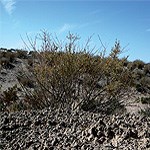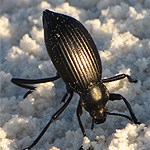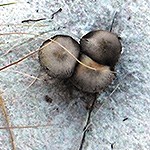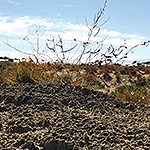
NPS Photo
Air, water, and soil are the three natural resources that are vital to life on earth. Most of us easily recognize the importance of air and water in our daily lives. Each time we take a breath or a sip of water the importance of both are apparent, but how often do we think of the soil beneath our feet as vital to our existence?

NPS Photo Soil Soil is the top layer on the earth surface. Soil provides many important functions for plants, animals, and humans. It supports growing plants, trees, crops and millions of organisms. Most of our food depends on soil. Soil filters pollutants from our environment and from our drinking water. It regulates the flow of water through the landscape before it ends up in plant roots, aquifers and rivers. Soil is the foundation of our buildings and roads. It also protects and preserves our history and our past in archeological sites. What is soil? Soil is made up of four main components: mineral grains, organic matter, water, and air. The largest component is mixture of mineral grains from broken down rocks and sediment created by the effects of wind, rainfall, snow, freezing, and thawing. This layer forms slowly over hundreds of years. This mixture gives the soil texture which can be described as sand, loam, or clay. Organic matter forms from rotted and decomposed vegetation broken down by soil organisms. This is a very thin layer but an important one that acts like glue holding all four components together. The amount of water and air in the soil varies and is based on climate, soil texture, and water holding capacity. These four components make up a very complex ecosystem home to millions of livings creatures. 
NPS Photo Burrowing Animals Burrowing mammals are very common in semi-arid and arid landscapes. Their extensive underground pathways and dwellings provide protection from predators and weather extremes. These creatures can be as large as a badger or as small as a shrew. They include ground squirrels, pocket gophers, prairie dogs, kangaroo rats, pocket mice, and many other mammals. Their digging mixes subsurface materials with surface soils, litter, and feces. This helps fertilize the soil and buries carbon, which benefits many plants and soil microorganisms. Their burrows and tunnels allow water from high intensity storms to rapidly infiltrate into the soil instead of running off. Burrows carry oxygen deep into the soil, helping to aerate the soil around plant roots. Their burrowing activities help transport mycorrhizal and other fungus spores. Some mammals, such as kangaroo rats and pocket mice, bury seeds in caches that serve as a valuable seed source for plant establishment. The burying of organic matter with the seed provides a supply of nutrients for seedling survival. Small mammals consume and help control soil arthropod populations. 
NPS Photo Arthropods Soil arthropods are invertebrates with segmented bodies and jointed legs. They can be microscopic or quite large. There are lots of different arthropods such as insects, crustaceans, arachnids, and myriapods. They are the largest animal phylum. Arthropods fly, creep, and crawl. They are commonly thought of as bugs. Arthropods perform many different functions in the soil community. Some are shredders, others predators. Some arthropods eat plants, while others feed strictly on fungus. They aerate the soil, shred organic matter into small pieces and assist other soil organisms in the decomposition process. They help distribute beneficial microbes in the soil. Through consumption, digestion, and excretion of soil organic matter, soil arthropods help improve soil structure and change nutrients into forms available to plants. They regulate populations of other soil organisms, like protozoa, which help maintain a healthy soil food web and control disease-causing organisms. In turn, soil arthropods are consumed by burrowing mammals, birds, and lizards. 
Ana Child, Natural Resource Ecology Laboratory, Colorado State University Nematodes Nematodes are tiny roundworms that are common in soils everywhere. From the freezing Arctic to dry, hot deserts, one cubic foot of soil can contain millions of them. Nematodes can be most easily classified according to their feeding habits. Some graze on bacteria and fungi. Some like plant roots; others prey on tiny animals. Some will eat any of the above mentioned food items. Nematodes can’t move through the soil unless a film of moisture surrounds the soil particles. Under hot, dry conditions, nematodes can become dormant, allowing them to survive long periods of drought. When water becomes available, they quickly spring back to life. Among the thousands of species that have been identified, many are considered beneficial because they boost the nutritional status of the soil. Nematodes feed on decaying plant material, along with organisms that assist in the decomposition of organic matter (bacteria and fungi). This helps disperse both the organic matter and the decomposers in the soil. Increased organic matter concentration and decomposition boost nitrogen and phosphorus levels. Because some nematodes prey on other animals, they can be useful for control of pest insects. Nematodes aren’t all good. Some damage the roots of domestic crops, costing U.S. farmers an estimated $8 billion a year. 
Wilhelm Foissner, Institute of Zoology, Protozoa Protozoa are tiny single-celled animals that mainly feed on bacteria. They are microscopic and a pinch of soil can contain thousands. All protozoa need water to move through soil, however, they only need a thin film surrounding the soil particles to get around. Protozoa are found in soils everywhere: even in very dry deserts. However, they are most abundant near plant roots because that’s where both bacteria and organic matter are concentrated in the soil.
Protozoa play an important role: they eat bacteria and release nitrogen and other nutrients in their waste. Since protozoa are concentrated near plant roots, the plant can benefit from this supply of nutrients. Protozoa can stimulate the rate of decomposition by maximizing bacterial activity. Protozoa are in turn consumed by nematodes and microarthropods. Not all protozoa are beneficial. Some protozoa attack roots and cause disease in rangeland plants. However, other protozoa feed on root pathogens, thus reducing plant disease. 
SSSA Bacteria Bacteria are minuscule one-celled organisms that can only be seen with a powerful light or electron microscope. They can be so numerous that a pinch of soil can contain millions of organisms. Bacteria are tough—they occur everywhere on earth and have even been found over a mile down into the core of the earth. Bacteria are common throughout the soil but tend to be most abundant in or adjacent to plant roots, an important food source. Bacteria are important in the carbon cycle. They contribute carbon to the system by fixation (photosynthesis) and decomposition. Actinomycetes are particularly effective at breaking down tough substances like cellulose (which makes up the cell walls of plants) and chitin (which makes up the cell walls of fungi) even under harsh conditions, such as high soil pH. Bacteria are particularly important in nitrogen cycling. Free-living bacteria fix atmospheric nitrogen, adding it to the soil nitrogen pool. Other nitrogen-fixing bacteria form associations with the roots of plants and fix nitrogen, which is then available to both the host and other plants in the near vicinity. Some soil nitrogen is unusable by plants until bacteria converts it to forms that can be easily assimilated. Some bacteria exude a sticky substance that helps bind soil particles into small aggregates. So despite their small size, they help improve water infiltration, water-holding capacity, soil stability, and aeration. As long as soil bacteria does not get out of balance, it suppresses root-disease in plants by competing with pathenogenic organisms. Bacteria are becoming increasingly important in bioremediation. Bacteria are capable of filtering and degrading a large variety of human-made pollutants in the soil and groundwater so that they are no longer toxic. The list of materials they can detoxify includes herbicides, heavy metals, and petroleum products. 
NPS Photo Fungi Mycorrhizal fungi colonize the roots of many plants. Mycorrhizal fungi don’t harm the plant they develop a “symbiotic” relationship that helps the plant be more efficient at obtaining nutrients and water. In return, the plant provides energy to the fungus in the form of sugars. The fungus is actually a network of filaments that grow in and around the plant root cells, forming a mass that extends considerably beyond the plant’s root system. This essentially extends the plant’s reach to water and nutrients, allowing it to utilize more of the soil’s resources. This makes the plant stronger, especially during drought periods. A stronger individual plant means that the entire community is more resilient to disturbance. Some mycorrhizae may even protect their host plant against unwanted pathogens. Not all fungi are mycorrhizal. There are also fungi that help decompose the organic matter in litter and soil. However, they play a lesser role than bacteria in this important process in semi-arid and arid soils. Some plants are “mycorrhizal-obligate,” meaning that they can’t survive to maturity without their fungal associate like the Soaptree Yucca. Mycorrhizae are particularly important in assisting the host plant with the uptake of phosphorus and nitrogen, two nutrients vital to plant growth. 
NPS Photo Biological Crust Biological crust is a complex community of living organisms—algae, cyanobacteria, bacteria, lichen, mosses, liverworts, and fungi—that grow on or just below the soil surface. Biological soil crusts are common worldwide in arid and semi-arid shrublands, grasslands, and woodlands. They are highly variable in appearance. Which organisms dominate the crust is determined by several factors, including soil chemical and physical characteristics and weather patterns. Biological soil crusts are distinguishable from bare soil by a bumpy appearance, forming sort of a mini-landscape on the soil surface complete with hills and valleys. They tend to be dark in color, especially when dry. Biological soil crusts are known by many names such as Microbiotic , Cryptogamic , Cryptobiotic, Microphytic , and Microfloral but they all refer to the same thing: Biological soil crusts stabilize the soil. Some of the organisms secrete sticky substances (polysaccharides), which hold soil particles together. The crusts make the soil more fertile. Most of the organisms associated with the biological soil crust are photosynthetic, particularly during cold, wet seasons when most plants are dormant. This means that the biological soil crust increases the length of the time during which organic carbon is added to topsoil. Biological soil crusts can make other nutrients more available for use by grasses, forbs, and shrubs, as nutrients adhere to the sticky substances, and are prevented from leaching. Biological soil crusts may help the soil to retain more moisture depending on both the composition of the crust and soil characteristics. 
NPS Photo Cyanobacteria Cyanobacteria once known as blue green algae, makes up the largest part of the biological soil here at White Sands. Cyanobacteria combined with fungi form a bumpy lichen crust that protects the surface of the interdunes from erosion. This crust enables plants to grow in nutrient poor sand by building up soil layers and by stabilizing the ever shifting sand. Cyanobacteria takes nitrogen from the air and make it available for plants in the interdune area. They also provide firm footing for plants to take hold and root. It also feeds a host of tiny mites that live in the soil and in the leaves of plants and plant litter that accumulate under shrubs. Other mites graze on the fungi and transport the fungi spores to places where they will grow. Cyanobacteria can be found in almost every terrestrial and aquatic habitat. It is the oldest know fossil more than 3.5 billion years old and is the largest and most important group of bacteria on Earth. |
Last updated: July 29, 2023
